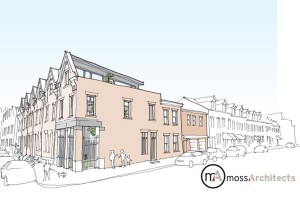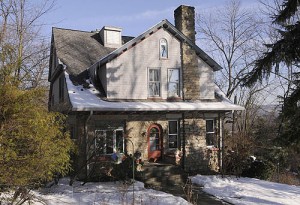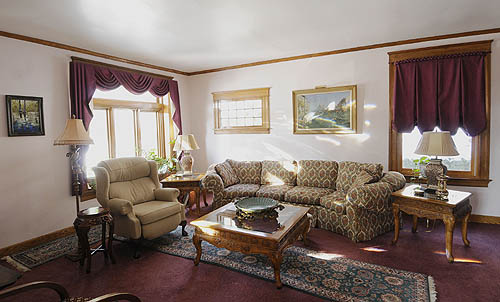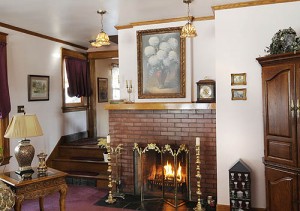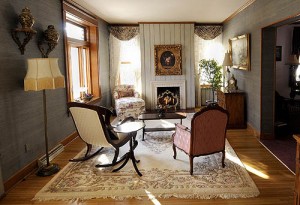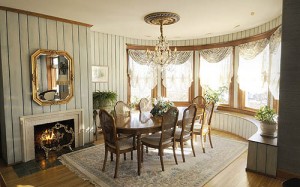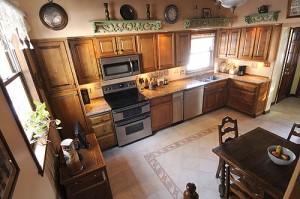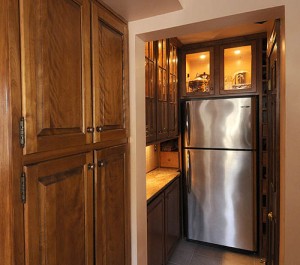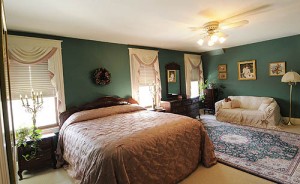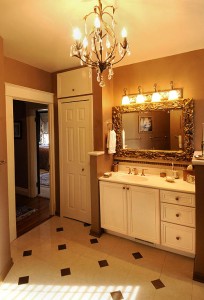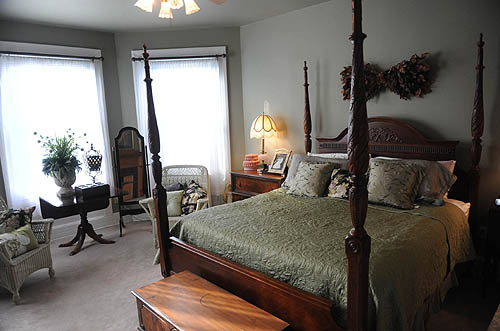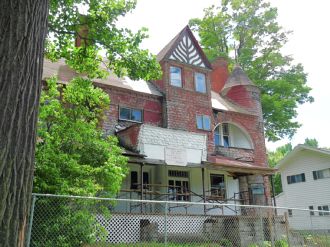
Category Archive: Property for Sale
-
Row of Vacant Lawrenceville Houses Being Restored with Historic Exteriors, Custom Interiors
Wednesday, February 02, 2011
Pop City Media
Since they were left vacant in 1995, the row of five historic brick houses on 48th Street, between Hatfield and Butler Streets, in Lawrenceville have fallen into terrible shape. With creative design and green construction, the homes are being restored to look the way they would have when they were built in the 19th century, but with customized modern interiors.
The City of Pittsburgh acquired the buildings, with the help of the Lawrenceville Corporation, in 2007 at very low cost using a tax lien process. After receiving proposals from many eager developers, the Lawrenceville Corporation closed on the sale last week with Botero Development, who’s principal Brian Mendelssohn lives in the neighborhood.
“They’re going to be a high quality product. We’re going to restore the exteriors using real materials, meaning real stone and real slate, and install stone steps and things like that to make them look like when they were built,” says Mendelssohn, who is working with Moss Architects on the project. The interiors will be custom-built for the aesthetic whims of the individual buyers, blending historic elements and original materials with modern features, such as stainless steel appliances, and energy efficient design aspects, like a 2-inch white rubber roof.
The homes, which are currently for sale, include four 1900-square-foot, 3-bedroom units with rear yards. Two come with 2.5-baths and the other two have 2-baths. One 1,250-square-foot unit has 2-bedrooms and 2-baths. The houses will be completed by next October and are priced between $180,000 and $265,000. A sixth building was beyond repair, but its lot will serve as a private courtyard for the $265,000 unit.
“I feel the prices are below market value for what these buildings are,” says Mendelssohn. “It will be good for the neighborhood not to start charging $300,000 for homes in Lawrenceville. You don’t want to gentrify your own neighborhood, you want to keep it what it is.”
Writer: John Farley
Source: Brian MendelssohnImage courtesy of Botero Development
-
Buying Here: Thornburg
Saturday, January 22, 2011By Gretchen McKay, Pittsburgh Post-GazetteBidding wars are not common in Pittsburgh. Every once in a while, though, multiple buyers will set their collective hearts on a house in a much-desired neighborhood. Linda Padget and her husband, John Miller, had to outbid eight others to buy the nearly century-old Craftsman-style house at 508 Yale Road in Thornburg that is currently for sale by owner for $389,900 (www.oldhouses.com, No. 5121).
The couple adored the big Victorian they’d spend years restoring in nearby Crafton, but not its location at a noisy intersection.
“We wanted peace and quiet,” recalls Ms. Padget, who paid $243,500 for the house in 1999. “This was out of the way, with virtually no traffic.”
Laid out in 1899 by two cousins who subdivided 250 acres of family farmland, Thornburg has curving, shaded streets named after Ivy League colleges and many large, Craftsman-style homes that appealed to turn-of-the-century Edwardian sensibilities. The Thornburg Land Co. advertised the new development in the Chartiers Valley Mirror as a “high-class residence district.” The borough, most likely modeled after New York’s blue-blood Tuxedo Park, also had one of the first private golf courses in Allegheny County (members cut the grass on Saturdays and played on Sundays) along with a community club and a community theater founded in 1937.
Just 10 minutes from Downtown, Thornburg has remained a family-centered town with a lively community spirit: Both the Thornburg Community Club and Village Players are still active; the golf course, which fell into private hands for a time, is now a conservation area with walking trails for residents.
A few of Thornburg’s homes are true mansions, including the Frank Thornburg House built in 1907 on Lehigh Road, which has 7,000 square feet of living space, seven bedrooms and 10 fireplaces. The Miller-Padget house, built in 1904, is more modest, with five bedrooms, three working fireplaces with original tile hearths and just under 4,000 square feet of space.
Located on a professionally landscaped lot in the historic district, the 21/2-story house is believed to be one of the borough’s original dozen or so houses. Its exterior is constructed of fieldstone and cedar shakes; there’s also a driveway leading to a two-car detached garage. While it has been updated with cosmetic changes, none of its six or seven owners over the past 100 years made the mistake of significantly modernizing its rooms or exterior.
“Everyone took very good care of it,” says Ms. Padget. “They kept the integrity intact.”
Original hardwood floors, brass hardware and leaded-glass transoms are among the period details that dress up the first floor, which includes a 15-by-19-foot family room. There’s also a 20-foot oak bay with a cushioned window seat in the 13-by-19-foot dining room, parts of which are wallpapered with pale blue silk grass cloth.
An adjoining 12-by-15-foot living room has mahogany paneling, with windows overlooking the side yard. At first, the couple wasn’t too keen on the light blue tint of the stain on the paneling (probably not original). But they feared the room would be too dark if they stripped it and stained it dark mahogany. The color ended up growing on them.
The recently updated eat-in kitchen features stainless-steel appliances, cherry cabinets and granite countertops; they also turned a closet into a butler’s pantry with glass-fronted cabinets, fridge and a wine rack. Accent tiles in the backsplash depict Italian scenes; the copper ceiling is faux.
The second floor holds a 14-by-29-foot master bedroom with a pair of walk-in closets and a window seat. The master bath, brightened by a skylight, has a whirlpool tub. The smaller of two additional bedrooms serves as a home office, and there’s also a newly remodeled main bath with a porcelain floor.
The attic has two more bedrooms — one with a wood floor and the other carpeted — and a 10-by-16-foot “bonus” room that’s currently used for storage.
The finished basement has a game room/den with wall-to-wall carpeting, a 9-by-14-foot cedar closet and a store room/shop with built-in shelving. A vintage quartersawn-oak Banta icebox is used by the current owners as a bar. Since it’s too massive to move, it comes with the house.
The fenced-in backyard is surrounded by mature trees that cloak the house in privacy in spring and summer. Year-round, there’s a fabulous view from the 14-by-33-foot deck off the kitchen, outfitted with a built-in gas grill, below-railing lighting and stereo with quadraphonic sound.
“At night, you can see the sparkling lights of Sheraden and Ingram,” says Ms. Padget, It is, she says, their favorite spot in the house. “We spend seven months of the year out here.”
No properties have changed hands on Yale Road in the past several years, but homes have sold on other streets in the neighborhood with prices ranging from $160,000 on Cornell Avenue to $347,5000 on Harvard.
To request a brochure on 508 Yale Road, call 412-921-0508 or e-mail padgetmiller@verizon.net.
-
Buying Here: Oakmont
A fine arts-and-craft home for a young family
Sunday, January 09, 2011By Gretchen McKay, Pittsburgh Post-Gazette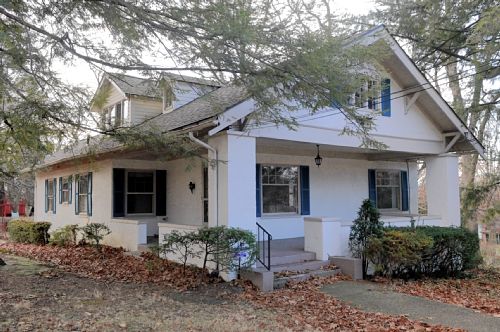
This home on California Avenue in Oakmont is on the market for $249,900. Bob Donaldson / Post-Gazette
Oakmont is probably best known for its luxurious country club, home to a famously difficult golf course that’s hosted more combined USGA and PGA championships than any other course in America. But its roots actually were planted in industry; early employers along the Allegheny River included Allegheny Valley Railroad, Woodings-Verona Tool Works and Agnew & Co., one of the most prolific glass companies in Pittsburgh at the turn of the 20th century.
Along with the elegant (and uber-expensive) homes that sprang up on Hulton Road about the same time as the club, the borough is blessed with a variety of more modest turn-of-the-century homes. Pretty as a picture is a 11/2-story Craftsman bungalow at 710 California Ave. (MLS No. 842126), constructed 11 years after Oakmont incorporated as a borough in 1889. It is being offered by Howard Hanna Real Estate’s Shadyside office for $249,900 (www.howardhanna.com; 412-361-4000).
The Arts and Crafts Movement flourished in England in the mid 1800s. Yet the style — marked by architectural simplicity and natural materials — didn’t catch on in the U.S. until decades later, in the early 1900s. After the fussy opulence of the Victorian era, American homeowners welcomed uncomplicated designs that were easy to envision, build and maintain. Architect/furniture designer Gustav Stickley’s “The Craftsman” magazine, first published in 1901, proved so popular that the 200-plus house plans he designed for its pages eventually were published in two books.
Situated on a double corner lot within easy walking distance of the shops and restaurants on Allegheny River Boulevard, this house features the style’s characteristic low-pitched, gabled roof and covered front porch. Inside, the rooms are large, with minimal ornamentation, high ceilings and lots of windows. Some could some updating.
First-floor bedrooms might seem like a Baby Boomer invention, but they actually were fairly common in Craftsman bungalows. This 2,500-square-foot house has two on the main level, including a 13-by-13-foot master, plus two more upstairs. Something else that will appeal to modern sensibilities: There’s a full bath on both floors.
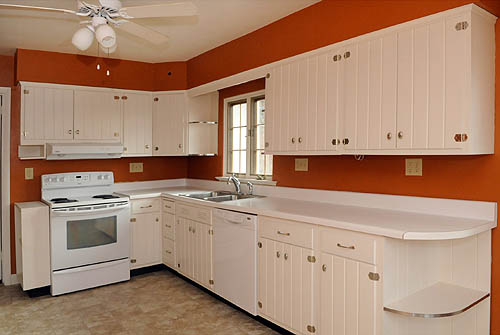
The 15-by-10-foot eat-in kitchen opens onto a 15-by-14-foot formal dining room. Bob Donaldson/Post-Gazette
The updated, eat-in kitchen measures 15 by 10 feet and is brightened by white wood cabinets and white appliances. It opens onto a 15-by-14-foot formal dining room, which adjoins a 20-by-14-foot living room with built-in bookcases and a working fireplace. Hardwood floors run throughout the first floor; out back is a one-car detached garage.
The large yard and quiet, tree-lined street make it a perfect starter house for a young family, says listing agent Justin Cummings. With most of the living space on the first level, it also should appeal to older couples who are downsizing but still need bedrooms for grandchildren and other visitors.
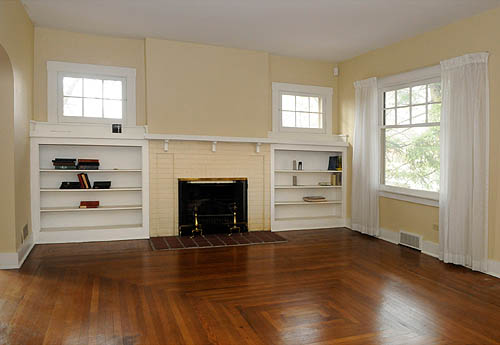
The 20-by-14-foot living room features built-in bookcases and a working fireplace. Hardwood floors run throughout the first floor. Bob Donaldson/Post-Gazette
The current owner paid $265,000 for the house in 2007. It has a 2010 full market value of $175,000
(www2.county.allegheny.pa.us).
In the past three years, eight homes have changed hands on California Avenue, ranging in price from $167,500 in May 2007 to $285,000 in July 2008 (www.realstats.net).
There will be an open house from 1 to 4 p.m. today. For more information, contact Justin Cummings of Howard Hanna’s Shadyside office at 412-361-4000 or www.howardhanna.com.
-
Some in Carrick Strive to Save Victorian House
Friday, December 24, 2010By Diana Nelson Jones, Pittsburgh Post-Gazette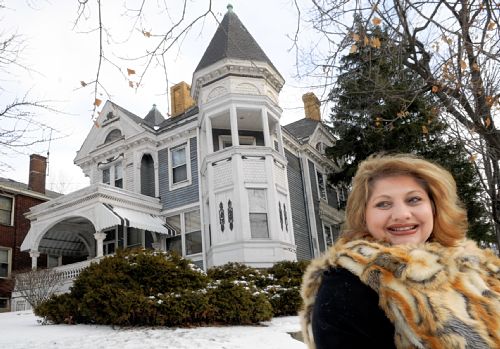
Julia Tomasic of the Carrick-Overbrook Historical Society is trying to save the last great Victorian home in Carrick, at 1425 Brownsville Road, by nominating it for historic status. Bob Donaldson/Post-Gazette
At one corner of Brownsville Road and The Boulevard in Carrick sits state Rep. Harry Readshaw’s funeral home. Across The Boulevard, a late-19th-century Queen Anne house is the last of the grand Victorians remaining on the main drag.
Its owners want to sell and may have a buyer in Mr. Readshaw, who said he is interested in buying the property and that demolishing it to provide parking “might be a decision to be considered.”
Mr. Readshaw’s interest has spurred the Carrick-Overbrook Historical Society to try to save the house.
Historical society member John Rudiak documented the property and this week nominated it for historical designation. He said demolition of the house would put an end to any evidence of Carrick’s Victorian heritage.
The nomination would stall any plan to demolish the house until the Historic Review Commission could determine whether it is eligible, based on a set of federal criteria. Eligibility ultimately must be decided by Pittsburgh City Council. Historic status regulates changes to a building’s exterior but not to its interior.
Richard C. Gasior, whose wife’s family has owned the four-bedroom home since 1952, said the family needs to sell it and has been advised that $150,000 would be a fair price. “If I can’t get anybody to buy it, I’m going to go with Readshaw,” he said.
Known as the Wigman House, it was built in the late 1800s by William Wigman, owner of Wigman Lumber on the South Side. The nomination states that it is “the last remaining example of several homes of the wealthy South Side gentry who lived in Carrick.”
The current owners gave a tour to members of the Carrick-Overbrook Historical Society several weeks ago, said Julia Tomasic, a founding member of the society.
“We’d love to buy it, but there are just three of us” in the society, which has no money, Ms. Tomasic said. “It has a brand-new furnace, a slate roof and the interior woodwork and walls in original hardwood, with six fireplaces, including one converted for wood. Nothing has been done to alter it.”
According to the Pittsburgh code for historic preservation, a property must meet at least one of 10 criteria to be eligible for preservation.
The nomination papers cite several possible eligibilities. One is that the home, a classic American Queen Anne, has not been modified. Its features include an asymmetrical facade, front-facing gable, overhanging eaves, polygonal tower, shaped and Dutch gables, a porch covering part or all of the front facade, a second-story porch or balconies, pedimented porches, dentils, spindles, differing wall textures including fish scales, and oriel and bay windows.
“We heard rumors for a year that Harry [Readshaw] would buy it to tear it down, and we thought it was a joke because we consider Harry a friend of the neighborhood,” Ms. Tomasic said. “Parking? You park on the street. We’re city people.”
“It’s not like I’m sitting here champing at the bit with a sledge hammer,” Mr. Readshaw, D-Carrick, said, “but business is business and any business is looking to improve its services.”
“And if we don’t get it, what happens to it?” he said. “Somebody dying to live in a big Victorian who would be a wonderful neighbor would be a positive.” A Section 8 landlord is a more likely prospect, he said, adding, “The 29th Ward has been inundated with Section 8 housing.”
Brownsville Road once had several grand Victorian homes owned by prominent businessmen. As a hilltop neighborhood, Carrick was a refuge from the smoky city. Through much of the 20th century, it was solidly middle class and owner-occupied. It remains so, but some of its stability is eroding.
In its argument for historic status, the historical society calls the Wigman House the most prominent home in Carrick, “our crown jewel Victorian.” Losing it would be a shock, the document reads, and “one more loss that we cannot sustain.”
-
This Beautiful Structure Must Be Saved
Pittsburgh Post-Gazette
Wednesday, January 05, 2011 05:00 AM
*Open Letters is a place where the letters to the editor published by the Post-Gazette are offered up for broader comment and discussion.
The late 19th-century Queen Anne Victorian house on Brownsville Road in Carrick (“Some in Carrick Strive to Save Victorian House,” Dec. 24) is a gem that must be preserved.
The Carrick-Overbrook Historical Society has done a yeoman’s job by documenting the property known as the Wigman House and nominating it for historical designation. One hopes that other area historical societies and individual philanthropists will join together to assure its salvation.
While I was growing up on Madeline Street in Carrick, dozens of comparable homes in the area reflected the personalities of the moguls who built them on high ground in order to contemplate the night sky burned red by the glow of steel mills blazing far below.
My family’s physician, Dr. Askins, was able to purchase one such mansion on Brownsville Road during the Depression. The exterior, painted contrasting shades of green, emphasized the eerie atmosphere that would have captivated the Addams Family.
Each time we visited his office, I was startled by creaking sounds — veritable moans — coming from one of the turrets. When I asked him about them, he tossed me a sly smile. “Those are the ghosts of the original owners,” he said. “They cannot bear to leave the tower and lose sight of the city they built.”
Just as those ghosts clung to the past, so must the ghosts of the last remaining Victorian mansion in Carrick be appeased.
EMILY PRITCHARD CARY
Scottsdale, Ariz. -
Washington County Farm on Statewide Danger List
Monday, December 20, 2010By Len Barcousky, Pittsburgh Post-GazetteA Washington County farm that has been operated by the same family for more than 200 years has been included on a list of 10 historic sites most at risk across Pennsylvania.
Longwall coal mining could harm several historic buildings at Plantation Plenty in Independence Township, according to Preservation Pennsylvania. The nonprofit organization released its list of endangered properties on Thursday.
State and federal environmental and preservation regulations require an analysis of the impact of commercial activities like mining on historic properties, according to Erin Hammerstedt, a field representative for Preservation Pennsylvania and the National Trust for Historic Preservation.
“Our goal would be to keep longwall mining out of this historic farm,” she said.
Preservation Pennsylvania is a private membership organization that seeks to protect historically and architecturally significant properties. The National Trust for Historic Preservation, created by Congress in 1949, plays a similar role across the country.
Plantation Plenty has been operated since 1800 by Isaac Manchester and his descendants. Joseph Pagliarulo and his wife, Margie, who is a Manchester descendant, acquired the 400 acres in 2005 and now run it as an organic farm, producing milk, beef, pork and vegetables.
The Manchester family had sold coal rights to the property in 1915, except for three acres under the farmhouse and other nearby buildings. The mining rights are owned by Penn Ridge Coal, a subsidiary of Alliance Resource Partners, a Tulsa, Okla.-based coal producer with $1.2 billion in revenues.
While longwall mining would never occur directly under the farmstead, major mine subsidence nearby still could damage the structures, Ms. Hammerstedt said. Another possible side-effect of the mining could be to degrade or ruin the farm’s water supply by fracturing the rock that feeds its springs and wells, according to Preservation Pennsylvania.
Penn Ridge has not yet applied for mining permits, Mr. Pagliarulo said, but he fears “it is just a matter of time.” He said it is not financially possible for him and his wife to buy back the coal rights.
An end to farming on the Manchester property would represent a cultural and environmental loss, he said.
“This property has been in my wife’s family for more than 200 years,” he said. “A visit here lets you step back in time … and see how 18th and 19th century farming took place.”
Two other Western Pennsylvania properties or areas are on the preservation organization’s list.
Holland Hall in Meadville, which has been vacant for 15 years, is in danger of demolition, according to Preservation Pennsylvania. The poor condition of the building — many interior walls and electrical, plumbing and heating mixtures have been removed — make it attractive to a buyer who would tear it down and replace it with a new structure.
Holland Hall was built in 1899 by A.C. Huidekoper, a Civil War veteran who made fortunes in coal, iron, oil and railroad businesses. The Gilded Age mansion was built around a smaller red-brick building constructed in 1804. Mr. Huidekoper and his wife, Frances, had lived in the smaller structure before the larger house was built.
Following the death of Mrs. Huidekoper, Holland Hall was sold and used as a fraternity house from 1935 to 1995. Plans to redevelop it as a conference center and bed-and-breakfast fell through.
“In order to prevent the demolition or continued neglect of Holland Hall, a buyer interested in acquiring and rehabilitating this architecturally significant building is needed,” according to “Pennsylvania at Risk 2010,” the organization’s newsletter.
Plans for a wind farm on the crest of Evitts Mountain in Bedford County’s Bedford Township could endanger a rural historic district known as Dutch Corner, according to Preservation Pennsylvania.
Dutch Corner has more than 30 farmsteads and a historic school, church and several cemeteries.
Plans to build 24 wind turbines on the ridge above the valley would require blasting and filling to construct concrete foundation pads and to bury a transmission cable, according to the organization. It also warns that noise from the wind turbines would disturb the neighborhood’s rural character while the blasting could affect water supplies.
Preservation Pennsylvania does not oppose either longwall mining or wind farms in general, Ms. Hammerstedt said. “There are places where these activities are a good thing,” she said. “But there are other areas where these projects are not appropriate, because they would endanger historic buildings or landscape features.”
Preservation Pennsylvania’s 2010 list of at-risk sites is available on its Web site, www.preservationpa.org.
-
Buying Here: Bellevue
Saturday, December 04, 2010By Rosa Colucci, Pittsburgh Post-Gazette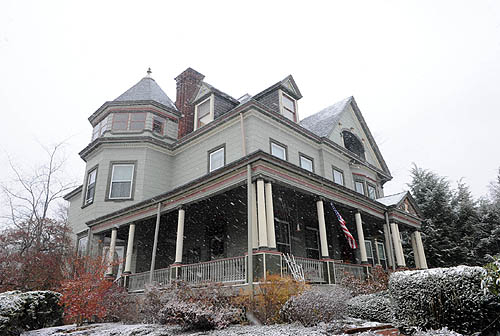
This five-bedroom, 4 1/2-bath home in Bellevue has 5,500 square feet of living space. Michael Henninger/Post-Gazette
“It takes my breath away every time I walk through the front door. It’s a warm, wonderful house,” says Sharon Hruska of her house in Bellevue.
There are very few houses that can evoke that feeling, but she isn’t exaggerating. Her five-bedroom, 4 1/2-bath Queen Ann-style house at 108 Meade Ave. (MLS No. 841177) is on the market for $299,000 through RE/MAX Realtors Don and Kathy Seaton (724-933-6300, ext. 664; or www.seatonteam.com).
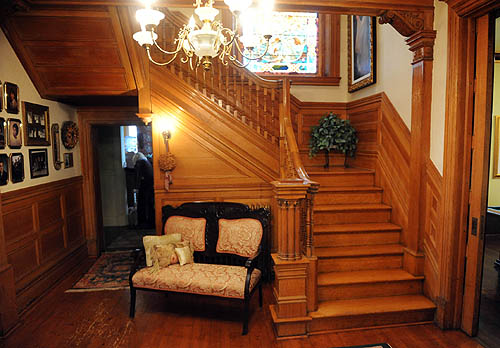
The home was built in 1898 by a lumber mill owner, who spared no expense on the wood work, including the entryway that has a carved oak staircase. Michael Henninger/Post-Gazette
When you open the front door, you are greeted by a 30-by-8-foot entryway that features a carved staircase in gleaming oak. The home was built in 1898-99 by Michael Simon, who owned a lumber mill and spared no expense.
When Sharon and Ken Hruska purchased it in 1993 for $40,000, its more than 5,500 square feet of living space was divided into nine apartments. The splendid foyer and all other woodwork were painted white. The couple spent a year restoring the home before moving in.
“My husband stripped the foyer. It took him one solid year; he worked every single day,” Mrs. Hruska said.

There is plenty of room to entertain in the 19-by-16-foot family room. Michael Henninger/Post-Gazette
This and other labors of love are evident in every nook and cranny of this grand home. The main living level has six fireplaces and an assortment of rooms perfect for entertaining. The living room (parlor) measures 18 by 16 feet and has 9-foot ceilings, tall windows and a picture rail. The 19-by-16-foot family room has a carved fireplace and a more masculine feel, decorated in traditional leather. The dining room (26 by 15 feet) has a pair of chandeliers and another fireplace, this one with a ceramic tile hearth offsetting the hardwood floors that cover most of the first floor.
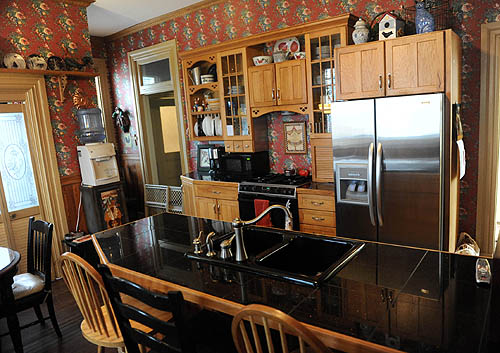
The 27-by-15-foot kitchen has granite counters and stainless-steel appliances. Glass-front cabinet doors flank the cooking area and accent exposed shelving. Michael Henninger/Post-Gazette
The 27-by-15-foot kitchen is a cook’s dream, with granite counters, stainless-steel appliances and an exposed-brick wall that nicely complements the modern appliances and amenities. Glass-front cabinet doors flank the cooking area and accent exposed shelving.
Nearby is the 18-by-16-foot den that doubles as a billiards room. Rounding out the main level is laundry room that measures 16 by 16 and a powder room.
A back staircase offers access to the huge third floor that could be rented as a full apartment. The space has three bedrooms, a full kitchen, living room and full bathroom.
Going up the front staircase to the second floor, be sure to stop to admire the majestic stained-glass window that the homeowners were able to retrieve and put back in place years after they bought the house.
The master bedroom has a trio of windows, a full master bath suite with a jetted tub that faces a fireplace, a stand-alone shower and a pedestal sink. There are two more full bathrooms and two more bedrooms (one of which is being used as an office). Room sizes range from 14 by 14 feet to 17 by 16 feet.

The master bath has a jetted tub that faces a fireplace, a stand-alone shower and a pedestal sink. Michael Henninger/Post-Gazette
The home is heated by radiator heat and cooled by room air conditioners, which stay with the home. Outside, the stunning wrap-around porch could entertain 50 people. The homeowners added a separate three-car garage to accommodate family and friends.
Now planning to downsize, the Hruskas say their grandchildren don’t want them to leave this house and friendly neighborhood, where many young families have moved recently. The house is open by appointment.
The property has a full market value of $155,000 (www2.county.allegheny.pa.us/RealEstate). In the past three years, four properties have sold on Meade Avenue ranging in price from $48,900 in April 2010 to $113,000 in June 2008 (www.realstats.net).
“Sometimes you go in big old houses [and] they have a creepy, scary feeling,” Mrs. Hruska said. “We have always felt at home here since the day we walked through the front door.”
 Bellevue
Bellevue
At a glance- Website: bellevueboro.com
- Size: 1.1 square miles
- Population: 8,770 (2000 census)
- School district: Northgate (northgate.k12.pa.us)
- Enrollment: 1,294
- Average 2010 SAT scores: 476 verbal; 494 math; 470 writing
- Current taxes on 108 Meade Ave. (full market value of Strong55,000): $6,019
- Municipality: $1,085 (7 mills)
- School district: $4,278 (27.6 mills)
- County: $656*
- Wage tax: 1 percent, split between municipality and school district
- A little bit of history: Like many northern suburbs, Bellevue originally was part of the Depreciation Lands reserved for Revolutionary War veterans. It has the distinction of being incorporated in 1876 only after Frankie East was born. Frankie’s birth gave the town a population of 300, the necessary prerequisite for residents to file a petition for incorporation with the Allegheny County Court of Quarter Sessions.
*Includes the Act 50 Homestead Exclusion, which reduces assessed market value by $15,000 for county taxes.
-
Jones’ Cresson Home May Avoid Razing
Saturday, November 20, 2010By Patricia Lowry, Pittsburgh Post-GazetteThe Cresson Area Historical Association, which has owned the 14-room, Queen Anne-style house since 1990, has a tentative agreement to sell it to Andrew and Carrie Dziabo, who grew up nearby and live just a few minutes away.
The tentative agreement, reached Friday, appears to have the blessing of Cresson Township supervisors, who heard the couple outline their plans at a township meeting earlier this month.
“We’re still working on it,” said Mr. Dziabo (pronounced zay-bo). “There are issues that need to be worked out, but it’s looking promising.”
The dilapidated house has been under threat of demolition since a Cambria County judge approved its razing in late 2008. Supervisors had told the historical association the house could be torn down after Sept. 30.
A member of the historical group wrote in an e-mail that the house would be sold for a nominal fee, with the new owners also paying the township’s legal expenses incurred during the long court proceedings. Mr. Dziabo referred questions about sale price to the township solicitor, who was unavailable Friday.
Mr. Dziabo grew up a block away from the Jones cottage, in a historic house that also was part of the Mountain House resort grounds. He worked with his father, civil engineer Michael Dziabo, on restoring that house, and the two plan to collaborate on this one.
While Andrew Dziabo, who works for a power company, has admired the Jones house since he was a child, it wasn’t until the historical group offered tours in the spring that he was able to see the interior.
“The house isn’t in as bad shape as I thought,” he said. “It’s actually very sturdy inside. There is some water damage that ate the plaster in a lot of the rooms, but as far as the structure goes, it seems pretty sound and sturdy. The floors don’t even creak.”
The Dziabos intend to restore the exterior and preserve as much of the interior woodwork as they can.
“The whole appeal of it to my wife and me is the character of the Victorian-style home,” he said, adding that its ornate, well-preserved foyer and staircase “would be very easy to restore. It’s just a matter of elbow grease.”
The Dziabos expect to know soon whether the Jones cottage is theirs.
“The township wants to have this issue to bed by the next [supervisors] meeting.”

